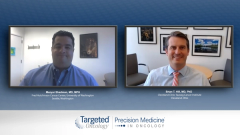
CD19-Targeted mAbs in R/R DLBCL Using Tafasitamab Continued
The discussion of tafasitamab as a monoclonal antibody therapy option for relapsed/refractory diffuse large B-cell lymphoma continues.
Episodes in this series

Brian T. Hill, MD, PhD: Since we’re talking about tafasitamab, Mazyar, please remind me about the RE-MIND trial. The RE-MIND trial wasn’t a trial at all, was it? It was just sort of a comparison effort, and maybe you want to speak to that.
Mazyar Shadman, MD, MPH: The terminology becomes confusing; let’s just go back and remind everybody that L-MIND was the single-arm study, the registration study that we just talked about, that’s a combination of tafasitamab and len [lenalidomide]. Then the question was how do you know that it wasn’t just len [lenalidomide], and where is your comparison with just lenalidomide monotherapy? For that, of course this wasn’t a randomized trial, so they didn’t have the len [lenalidomide] monotherapy. What happened, there was a study called RE-MIND, and this was a real-world control cohort for the L-MIND study. This was a retrospective analysis looking at around 500 patients who received single-agent lenalidomide, and they had a 1:1 match. They basically selected 76 patients from the RE-MIND cohort, and they had a 1:1 match with the L-MIND study.
With the primary end point of overall response, they compared the outcomes, and with that primary efficacy analysis that they did, and the odds ratio was in favor of the combination—it was around 3.9 or 4.0—basically an overall response rate of 67% in len/tafa [lenalidomide/tafasitamab] from the L-MIND study compared to what they got from len [lenalidomide] monotherapy, which was 34% from the RE-MIND study. That, of course, translated to a better progression-free survival and overall survival. It’s another way that the FDA is accepting data, kind of combining clinical trials and looking at some real-world and retrospective data. There is a RE-MIND2 study that is another retrospective, comprehensive assessment of treatments for large cell lymphoma.
From a practical standpoint, of course with lenalidomide we’re always concerned and we monitor patients for cytopenias. We look at the common adverse effects from the L-MIND study, the combination, neutropenia seems to be very common, around 50% of patients had grade 3 or more neutropenia. This is with the longer follow-up. Anemia was less than 10% grade 3 or 4, and thrombocytopenia was around 18%, and we talked about the long-term results. I see it as an important treatment combination that doesn’t require a lot of effort from patients in terms of needing to travel, getting to a large center, and in patients who respond, especially if their quality of response is good, it can provide a long remission for them.
This transcript has been edited for clarity.







































